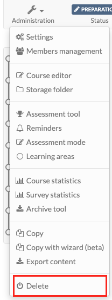OpenOlat courses enable the mapping of various event formats e.g. lectures, seminars, online tutorials or group puzzles, as well as the implementation of different types of learning, e.g. problem-based learning, cooperative learning, self-organized learning etc. A maximum of flexibility is guaranteed by using any number of course elements in any order of your choice; therefore it is easy to realize your didactic concept.
Apply for author rights at your OpenOlat support office and you can get started!
The course cycle at a glance:
- Create course
- Set up, design course
- Set up access
- Publish course status
- Execute course
- End course
- Delete course
Step | Action | Further Information |
1. Create course | Creating a Learning Resource Course in the Author Area and choosing the course typ "Learning path" or "Conventional course" | |
2. Set up, design course, publish | You implement your course in the course editor by selecting suitable course elements, creating learning resources if necessary, and configuring everything as desired. | |
3. Set up access | In the administration menu "Settings" the necessary settings for the access are made. The "Share" tab is particularly important here. | |
4. Publish course status | In the course toolbar set the status to "published". | |
5. Execute course and evaluate assessment modules | Now especially the assessment tool is needed and further actions are carried out directly in the course, e.g. forums are supervised, absences are organised etc. | |
6. End course | If the course has expired, the status is set to "finished". | |
7. Delete course | The "Delete" of the course is done via the appropriate menu in the course administration. Deleted courses can be shown or hidden in the authoring area via the filter option in the life cycle or specifically displayed in the "Deleted" tab. |
Note: Before you create your OpenOlat course:
First think about what you want to achieve with the course.
What the course looks like depends on your didactic concept, the goals and the overall framework. On this basis, you can decide whether a conventional course or a learning path course is the right choice for you. If in doubt, opt for the conventional course, as you can convert it into a learning path course at any time. The other way around is not possible.
Choose after the decision the optimal and most effective course elements and try to bundle things that belong together in a meaningful way to achieve optimal usability. When the structure is clear, prepare the learning content, additional files (HTML pages, PDF files, CPs, etc.) and everything you need for use in the learning platform.






